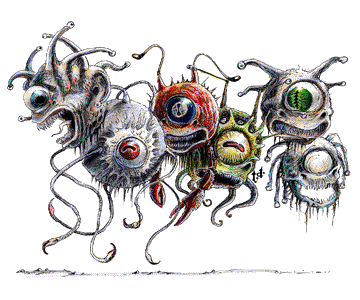
I’ve recently become a huge fan of the Beholder. I’ve known this D&D monster for a long time, but only now do I consider myself a fan of it. Is it because, as a fan of Pathfinder, I think the Bestiary is missing something without the famous Eye Tyrant and the equally aberrational Mind Flayer being in the book? At this point they’re the only reason why my Monster Manual 3.5 is not put away in a box.
An interesting aspect of Beholders is how they will hate other Beholders if they look different from them, even slightly. And there are quite a few variants of them, even ignoring the differences between editions. So that got me thinking… A crafty DM should make the most of that!
Beholders are scary creatures! They can kill you with a single glance! (Well, sort of.) But they’re such a classic monster that many adventurers might know what to expect from them. I’ve been thumbing through the ‘Lamentations of the Flame Princess’ three main books a lot lately, because they offer some great advice for role-playing games. Some of that advice works better for certain types of games than for a more ‘classic’ type of D&D. For example, the idea of only using original creations as monsters. I would do that when playing a more horror-based D&D, especially when using a more rules-light system like LotFP. But if I’m playing a more ‘classic’ game, and especially if it has a lot of crunch/rules and creating a monster from scratch is a lot of work from concept, to stats, to balancing, I’ll certainly use monster books!
And while I love the LotFP boxed set, it is also a bit unfair towards some of the classic D&D monsters. In my opinion, some of them are SCARIER because players are familiar with them, at least to a certain extent. I can think of many D&D players who would suddenly straighten up in their chairs if they were told their characters entered a room and came face to face with a Beholder! They would know things got serious! For decades, D&D has treated these monsters like a very, very serious threat and players have paid attention to that, or even have had characters disintegrated by one of their eye rays.
But on one aspect, I would agree completely with LotFP even in the case of the Beholder. For example, if players know in advance that they will face a Beholder and start preparing intelligently for that fight… Nothing wrong with players being smart, but at the same time, the Beholder has lost some of its mystique right there. So LotFP’s advice on monsters can actually pay off if you apply it to known monsters. Make them unfamiliar. (To be fair, in another section they do advice the GM to avoid the familiar aspects of a game or use them make it be something else and catch players off-guard.)
In the case of the Beholder, it couldn’t be easier. These guys have plenty of eye rays, and long-time players will know what every single one of those do. In that case… change the eye rays and have them do different effects. You could change one, or you could change all of them…
Think about how players might react if they come across a Beholder surrounded by freshly killed corpses, and suddenly it uses an Animate Dead eye ray on the dead bodies. Or what if a particular Beholder’s bite has a Vorpal effect and it can potentially bite an adventurer’s head off? (And if you really want to be gross, then spit it back out at another adventurer like a missile?) Or maybe its chitin surface deflects spells, or the Beholder has a Warp Magic effect like the Flail Snail?
It’s not because a monster is an icon of the game that it should be predictable. In fact, tweaking them from time to time (or every time, if it fits your campaign!) can keep them scary and fresh. Remember that Beholders are Aberrations, there’s no natural logic behind how they are. And if you’re using a game like 3.X where a close eye is kept on challenge rating/balance and you’re not sure how to approach tweaking a monster, simply replace one eye ray’s ability with another effect of the same equivalent spell level. Of course, 3.X templates can also go a long way to surprise players. Just remember, there’s many ways to keep a well-known monster scary beyond just inflating their HP and/or increasing their AC up to insanity.
Another thing I’d like to mention quickly, is that you should always remember that Beholders fly around. It’s been stated in D&D supplements already, but it bears repeating; Beholder lairs don’t need to be made with walking creatures in mind. The passages and tunnels can be completely vertical in places. Think of an ill-prepared group of adventurers who are running away from a particularly tough Beholder, only to find themselves stuck at a dead-end for them, since the following passage is too high to reach and goes upwards anyway! Or a group of adventurers climbing down one of said passages and suddenly being attacked by a flying Beholder in the middle of the climb, at a deadly height! The Beholder could simply float at a safe distance and blast them from there! That’s another way to make monsters scary, keep in mind that they are often found in their own environment, not in the player characters’. A smart party who goes into a Beholder’s lair should have access to the Fly spell, or a similar effect.
And don’t forget, if you include a Hive Mother in your game, you can have plenty of Beholder variants in a single, deadly encounter…
No comments:
Post a Comment